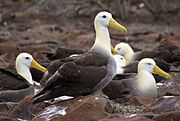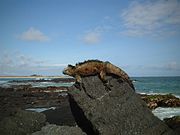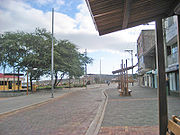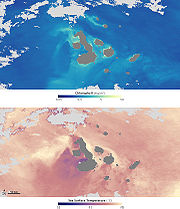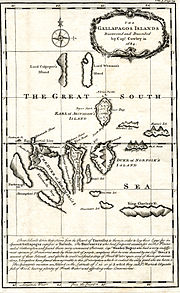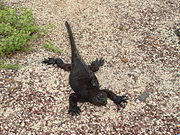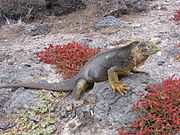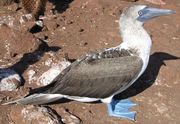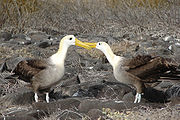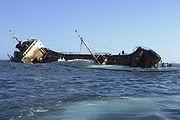
Galápagos Islands
About this schools Wikipedia selection
This content from Wikipedia has been selected by SOS Children for suitability in schools around the world. To compare sponsorship charities this is the best sponsorship link.
| Galapagos Islands | |
|---|---|
| Name as inscribed on the World Heritage List | |
 |
|
| Country | |
| Type | Natural |
| Criteria | vii, viii, ix, x |
| Reference | 1 |
| UNESCO region | Latin America and the Caribbean |
| Inscription history | |
| Inscription | 1978 (2nd Session) |
| Extensions | 2001 and 2003 |
| Endangered | 2007–2010 |
The Galápagos Islands (official name: Archipiélago de Colón; other Spanish names: Islas de Colón or Islas Galápagos) are an archipelago of volcanic islands distributed around the equator in the Pacific Ocean, 972 km (525 nmi) west of continental Ecuador, of which they are a part. Wildlife is its most notable feature.
The Galápagos islands and its surrounding waters form an Ecuadorian province, a national park, and a biological marine reserve. The principal language on the islands is Spanish. The islands have a population of around 23,000.
The islands are geologically young and famed for their vast number of endemic species, which were studied by Charles Darwin during the voyage of the Beagle. His observations and collections contributed to the inception of Darwin's theory of evolution by natural selection.
The first crude navigation chart of the islands was done by the buccaneer Ambrose Cowley in 1684. He named the individual islands after some of his fellow pirates or after the English noblemen who helped the privateer's cause. More recently, the Ecuadorian government gave most of the islands Spanish names. While the Spanish names are official, many users (especially ecological researchers) continue to use the older English names, particularly as those were the names used when Charles Darwin visited.
Physical geography
|
" id="mwe_player_0" style="width:180px;height:101px">
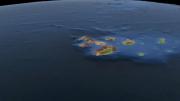
" id="mwe_player_2" style="width:180px;height:101px">
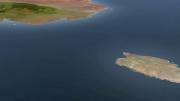 |
The islands are located in the eastern Pacific Ocean, 973 km (525 nmi; 605 mi) off the west coast of South America. The closest land mass is the mainland of Ecuador to the east (the country to which they belong), to the north is Cocos Island at 720 km (389 nmi; 447 mi) and to the south is Easter Island and San Felix Island at 3,200 km (1,730 nmi; 1,990 mi).
The islands are found at the coordinates 1°40'N–1°36'S, 89°16'–92°01'W. Straddling the equator, islands in the chain are located in both the northern and southern hemisphere, with Volcan Wolf and Volcano Ecuador on Isla Isabela being directly on the equator. Española, the southernmost island, and Darwin, the northernmost island, are spread out over a distance of 220 km (137 mi). The International Hydrographic Organization (IHO) considers them wholly within the South Pacific Ocean, however. The Galápagos Archipelago consists of 7,880 km2 (3,040 sq mi) of land spread over 45,000 km2 (17,000 sq mi) of ocean. The largest of the islands, Isabela, measures 4,640 km2 (1,790 sq mi) and makes up half of the total land area of the Galápagos. Volcán Wolf on Isabela is the highest point, with an elevation of 1,707 m (5,600 ft) above sea level.
The group consists of 15 main islands, 3 smaller islands, and 107 rocks and islets. The islands are located at the Galapagos Triple Junction. It is also atop the Galapagos hotspot, a place where the Earth's crust is being melted from below by a mantle plume, creating volcanoes. The oldest island is thought to have formed between 5 million and 10 million years ago. The youngest islands, Isabela and Fernandina, are still being formed, with the most recent volcanic eruption in April 2009, where lava from the volcanic island Fernandina started flowing both towards the island's shoreline and into the centre caldera.
Main islands
The 18 main islands (with a land area larger than 1 km2) of the archipelago (with their English names) shown alphabetically:
- Baltra (South Seymour) Island: Also known as South Seymour, Baltra is a small flat island located near the centre of the Galápagos. It was created by geological uplift. The island is very arid, and vegetation consists of salt bushes, prickly pear cacti and palo santo trees.
Until 1986, Baltra Airport was the only airport serving the Galápagos. Now, there are two airports which receive flights from the continent; the other is located on San Cristóbal Island. Private planes flying to Galápagos must fly to Baltra, as it is the only airport with facilities for planes overnight.
On arriving in Baltra, all visitors are immediately transported by bus to one of two docks. The first dock is located in a small bay, where the boats cruising Galápagos await passengers. The second is a ferry dock, which connects Baltra to the island of Santa Cruz.
During the 1940s, scientists decided to move 70 of Baltra's land iguanas to the neighboring North Seymour Island as part of an experiment. This move had unexpected results during the military occupation of Baltra in World War II; the native iguanas became extinct on the island. During the 1980s, iguanas from North Seymour were brought to the Charles Darwin Research Station as part of a breeding and repopulation project, and in the 1990s, land iguanas were reintroduced to Baltra. As of 1997, scientists counted 97 iguanas living on Baltra; 13 of which were born on the islands.
In 2007 and 2008, the Baltra airport was remodeled to include additional restaurants, shops and an improved visitor area.
- Bartolomé (Bartholomew) Island: Bartolomé Island is a volcanic islet just off the east coast of Santiago Island in the Galápagos Islands group. It is one of the "younger" islands in the Galápagos archipelago. This island, and neighboring Sulivan Bay on Santiago (James) island, are named after life-long friend of Charles Darwin, Sir Bartholomew James Sulivan, who was a Lieutenant aboard HMS Beagle. Today Sulivan Bay is often misspelled Sullivan Bay. This island is one of the few that is home to the Galapagos penguin which is the only wild penguin species to live on the equator. The green turtle is another animal that resides on the island.
- Darwin (Culpepper) Island: This island is named after Charles Darwin. It has an area of 1.1 square kilometers (0.4 sq mi) and a maximum altitude of 168 meters (551 ft). Here fur seals, frigates, marine iguanas, swallow-tailed gulls, sea lions, whales, marine turtles, and red-footed and Nazca boobies can be seen.
- Española (Hood) Island: Its name was given in honour of Spain. It also is known as Hood, after Viscount Samuel Hood. It has an area of 60 square kilometers (23 sq mi) and a maximum altitude of 206 meters (676 ft).
Española is the oldest island at around 3.5 million years, and the southernmost in the group. Due to its remote location, Española has a large number of endemic species. It has its own species of lava lizard, mockingbird, and tortoise. Española's marine iguanas exhibit a distinctive red coloration change during the breeding season. Española is the only place where the waved albatross nests. Some of the birds have attempted to breed on Genovesa (Tower) Island, but unsuccessfully. Española's steep cliffs serve as the perfect runways for these birds, which take off for their ocean feeding grounds near the mainland of Ecuador and Peru.
Española has two visitor sites. Gardner Bay is a swimming and snorkeling site, and offers a great beach. Punta Suarez has migrant, resident, and endemic wildlife, including brightly colored marine iguanas, Española lava lizards, hood mockingbirdss, swallow-tailed gulls, blue-footed boobies, Nazca boobies, red-billed tropicbirds,Galápagos hawks, 3 species of Darwin's finches, and the waved albatross.
- Fernandina (Narborough) Island: The name was given in honour of King Ferdinand II of Aragon, who sponsored the voyage of Columbus. Fernandina has an area of 642 square kilometers (248 sq mi) and a maximum altitude of 1,494 meters (4,902 ft). This is the youngest and westernmost island. On 13 May 2005, a new, very eruptive process began on this island, when an ash and water vapor cloud rose to a height of 7 kilometers (23,000 ft) and lava flows descended the slopes of the volcano on the way to the sea. Punta Espinosa is a narrow stretch of land where hundreds of marine iguanas gather, largely on black lava rocks. The famous flightless cormorants inhabit this island, as do Galápagos penguins, pelicans, Galápagos sea lions and Galápagos fur seals. Different types of lava flows can be compared, and the mangrove forests can be observed.
- Floreana (Charles or Santa María) Island: It was named after Juan José Flores, the first president of Ecuador, during whose administration the government of Ecuador took possession of the archipelago. It is also called Santa Maria, after one of the caravels of Columbus. It has an area of 173 square kilometers (67 sq mi) and a maximum elevation of 640 meters (2,100 ft). It is one of the islands with the most interesting human history, and one of the earliest to be inhabited. Flamingos and green sea turtles nest (December to May) on this island. The patapegada or Galápagos petrel, a sea bird which spends most of its life away from land, is found here. At Post Office Bay, since the 18th century whalers kept a wooden barrel that served as post office so that mail could be picked up and delivered to their destinations, mainly Europe and the United States, by ships on their way home. At the “Devil's Crown”, an underwater volcanic cone and coral formations are found.
- Genovesa (Tower) Island: The name is derived from Genoa, Italy where it is said Columbus was born. It has an area of 14 square kilometers (5.4 sq mi) and a maximum altitude of 76 meters (249 ft). This island is formed by the remaining edge of a large crater that is submerged. Its nickname of “the bird island” is clearly justified. At Darwin Bay, frigatebirds and swallow-tailed gulls, the only nocturnal species of gull in the world, can be seen. Red-footed boobies, noddy terns, lava gulls, tropic birds, doves, storm petrels and Darwin finches are also in sight. Prince Philip's Steps is a bird-watching plateau with Nazca and red-footed boobies. There is a large Palo Santo forest.
- Isabela (Albemarle) Island (Ecuador): This island was named in honour of Queen Isabela. With an area of 4,640 square kilometers (1,792 sq mi), it is the largest island of the Galápagos. Its highest point is Wolf Volcano, with an altitude of 1,707 meters (5,600 ft). The island's seahorse shape is the product of the merging of six large volcanoes into a single land mass. On this island, Galápagos penguins, flightless cormorants, marine iguanas, pelicans and Sally Lightfoot crabs abound. At the skirts and calderas of the volcanos of Isabela, land iguanas and Galápagos tortoises can be observed, as well as Darwin finches, Galápagos hawks, Galápagos doves and very interesting lowland vegetation. The third-largest human settlement of the archipelago, Puerto Villamil, is located at the southeastern tip of the island. It is the only island to have the equator run across it. It is also the only place in the world where a penguin can be in its natural habitat in the Northern Hemisphere.
- Marchena (Bindloe) Island: Named after Fray Antonio Marchena, it has an area of 130 square kilometers (50 sq mi) and a maximum altitude of 343 meters (1,125 ft).
Galápagos hawks and sea lions inhabit this island, and it is home to the Marchena lava lizard, an endemic animal.
- North Seymour Island: Its name was given after an English nobleman, Lord Hugh Seymour. It has an area of 1.9 square kilometers (0.7 sq mi) and a maximum altitude of 28 meters (92 ft). This island is home to a large population of blue-footed boobies and swallow-tailed gulls. It hosts one of the largest populations of frigate birds. It was formed from geological uplift.
Just north of the Baltra Airport is the small islet of North Seymour. North Seymour was created by seismic uplift, rather than being of volcanic origin. The island has a flat profile with cliffs only a few meters from the shoreline, where swallowtail gulls and tropicbirds sit perched in ledges. A tiny forest of silver-grey Palo Santo trees stand just above the landing, usually without leaves, waiting for rain to bring them into bloom. The island is teeming with life. While visiting the island, one may have to give way to a passing sea lion or marine iguana. Flocks of pelicans and swallow-tailed gulls feed off shore, and seasonally, Nazca boobies can also be seen.
North Seymour is an extraordinary place for breeding birds, and is home to one of the largest populations of nesting blue-footed boobies and magnificent frigate birds. Pairs of blue-footed boobies can be seen conducting their mating ritual as they offer each other gifts, whistle and honk, stretch their necks towards the sky, spread their wings, and dance—showing off their bright blue feet. Magnificent frigatebirds perch in low bushes, near the boobies, while watching over their large chicks. The frigates are huge, dark acrobats with a 90-inch (2.3 m) wingspan. Male frigates can puff up their scarlet throat sacks to resemble giant red balloons. Boobies and frigates have an interesting relationship. Boobies are excellent hunters and fish in flocks. The frigates by comparison are pirates, they dive bomb the boobies to force them to drop their prey. Then, the acrobatic frigate swoops down and picks up the food before it hits the water.
- Pinzón (Duncan) Island: Named after the Pinzón brothers, captains of the Pinta and Niña caravels, it has an area of 18 square kilometers (7 sq mi) and a maximum altitude of 458 meters (1,503 ft).
- Pinta (Abingdon) Island: Named after the Pinta caravel, it has an area of 60 km2 (23 sq mi) and a maximum altitude of 777 meters (2,549 ft). Sea lions, Galápagos hawks, giant tortoises, marine iguanas, and dolphins can be seen here. Pinta Island was home to the last remaining Pinta tortoise, called Lonesome George. He does not live on Pinta Island any longer, but at the Charles Darwin Research Station on Santa Cruz Island, where scientists are attempting to breed him.
- Rábida (Jervis) Island: It bears the name of the convent of Rábida, where Columbus left his son during his voyage to the Americas. It has an area of 4.9 square kilometers (1.9 sq mi) and a maximum altitude of 367 meters (1,204 ft). The high amount of iron contained in the lava at Rábida gives it a distinctive red colour. White-cheeked pintail ducks live in a saltwater lagoon close to the beach, where brown pelicans and boobies have built their nests. Until recently, flamingos were also found in the lagoon, but they have since moved on to other islands, likely due to a lack of food on Rábida. Nine species of finches have been reported in this island.
- San Cristóbal (Chatham) Island: It bears the name of the patron saint of seafarers, " St. Christopher". Its English name was given after William Pitt, 1st Earl of Chatham. It has an area of 558 square kilometers (215 sq mi) and its highest point rises to 730 meters (2395 ft). This is the first island in the Galapagos Archipelago Charles Darwin visited during his voyage on the Beagle. This islands hosts frigate birds, sea lions, giant tortoises, blue- and red-footed boobies, tropicbirds, marine iguanas, dolphins and swallow-tailed gulls. Its vegetation includes Calandrinia galapagos, Lecocarpus darwinii, and trees such as Lignum vitae. The largest freshwater lake in the archipelago, Laguna El Junco, is located in the highlands of San Cristóbal. The capital of the province of Galápagos, Puerto Baquerizo Moreno, lies at the southern tip of the island.
- Santa Cruz (Indefatigable) Island (Galápagos): Given the name of the Holy Cross in Spanish, its English name derives from the British vessel HMS Indefatigable. It has an area of 986 square kilometers (381 sq mi) and a maximum altitude of 864 meters (2834 ft). Santa Cruz hosts the largest human population in the archipelago, the town of Puerto Ayora. The Charles Darwin Research Station and the headquarters of the Galápagos National Park Service are located here. The GNPS and CDRS operate a tortoise breeding centre here, where young tortoises are hatched, reared, and prepared to be reintroduced to their natural habitat. The Highlands of Santa Cruz offer exuberant flora, and are famous for the lava tunnels. Large tortoise populations are found here. Black Turtle Cove is a site surrounded by mangroves, which sea turtles, rays and small sharks sometimes use as a mating area. Cerro Dragón, known for its flamingo lagoon, is also located here, and along the trail one may see land iguanas foraging.
- Santa Fé (Barrington) Island: Named after a city in Spain, it has an area of 24 square kilometers (9 sq mi) and a maximum altitude of 259 meters (850 ft). Santa Fe hosts a forest of Opuntia cactus, which are the largest of the archipelago, and Palo Santo. Weathered cliffs provide a haven for swallow-tailed gulls, red-billed tropic birds and shear-waters petrels. Santa Fe species of land iguanas are often seen, as well as lava lizards.
- Santiago (San Salvador, James) Island (Galápagos): Its name is equivalent to Saint James in English; it is also known as San Salvador, after the first island discovered by Columbus in the Caribbean Sea. This island has an area of 585 square kilometers (226 sq mi) and a maximum altitude of 907 meters (2976 ft). Marine iguanas, sea lions, fur seals, land and sea turtles, flamingos, dolphins and sharks are found here. Pigs and goats, which were introduced by humans to the islands and have caused great harm to the endemic species, have been eradicated (pigs by 2002; goats by the end of 2006). Darwin finches and Galápagos hawks are usually seen, as well as a colony of fur seals. At Sulivan Bay, a recent (around 100 years ago) pahoehoe lava flow can be observed.
- Wolf (Wenman) Island: This island was named after the German geologist Theodor Wolf. It has an area of 1.3 square kilometers (0.5 sq mi)and a maximum altitude of 253 meters (830 ft). Here, fur seals, frigatebirds, Nazca and red-footed boobies, marine iguanas, sharks, whales, dolphins and swallow-tailed gulls can be seen. The most famous resident is the vampire finch, which feeds partly on blood pecked from other birds, and is only found on this island.
Minor islands
- Daphne Major: A small island directly north of Santa Cruz and directly west of Baltra, this very inaccessible island appears, though unnamed, on Ambrose Cowley's 1684 chart. It is important as the location of multidecade finch population studies by Peter and Rosemary Grant.
- South Plaza Island (Plaza Sur): It is named in honour of a former president of Ecuador, General Leonidas Plaza. It has an area of 0.13 square kilometers (0.05 sq mi) and a maximum altitude of 23 meters (75 ft). The flora of South Plaza includes Opuntia cactus and Sesuvium plants, which form a reddish carpet on top of the lava formations. Iguanas (land, marine and some hybrids of both species) are abundant, and large numbers of birds can be observed from the cliffs at the southern part of the island, including tropic birds and swallow-tailed gulls.
- Nameless Island: A small islet used mostly for scuba diving.
Weather
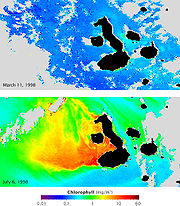
Although located on the Equator, the Humboldt Current brings cold water to the islands, causing frequent drizzles during most of the year. The weather is periodically influenced by the El Niño phenomenon, which brings warmer temperatures and heavy rains.
During the season known as the garua (June to November), the temperature by the sea is 22°C (72°F), a steady and cold wind blows from south and southeast, frequent drizzles (garuas) last most of the day, and dense fog conceals the islands. During the warm season (December to May), the average sea and air temperature rises to 25°C (77°F), there is no wind at all, there are sporadic, though strong, rains and the sun shines.
Weather changes as altitude increases in the large islands. Temperature decreases gradually with altitude, while precipitation increases due to the condensation of moisture in clouds on the slopes. There is a large range in precipitation from one place to another, not only with altitude, but also depending on the location of the islands, and also with the seasons.
The following table corresponding to the wet 1969 shows the variation of precipitation in different places of Santa Cruz Island:
| Location | Charles Darwin Station |
Devine Farm | Media Luna |
|---|---|---|---|
| Altitude | 6 m | 320 m | 620 m |
| January | 23.0 mm | 78.0 mm | 172.6 mm |
| February | 16.8 mm | 155.2 mm | 117.0 mm |
| March | 249.0 mm | 920.8 mm | 666.7 mm |
| April | 68.5 mm | 79.5 mm | 166.4 mm |
| May | 31.4 mm | 214.6 mm | 309.8 mm |
| June | 16.8 mm | 147.3 mm | 271.8 mm |
| July | 12.0 mm | 42.2 mm | 135.6 mm |
| August | 3.8 mm | 13.7 mm | 89.5 mm |
| September | 18.5 mm | 90.9 mm | 282.6 mm |
| October | 3.2 mm | 22.6 mm | 96.5 mm |
| November | 11.0 mm | 52.8 mm | 172.7 mm |
| December | 15.7 mm | 84.1 mm | 175.3 mm |
| TOTALS | 469.7 mm | 1901.7 mm | 2656.4 mm |
The precipitation also depends on the geographical location. During March 1969, the precipitation over Charles Darwin Station, on the southern coast of Santa Cruz was 249.0 mm (9.80 in), while on Baltra Island, the precipitation during the same month was only 137.6 mm (5.42 in). This is because Baltra is located behind Santa Cruz with respect to the prevailing southerly winds, so most of the moisture gets precipitated in the Santa Cruz highlands.
There are significant changes in precipitation from one year to another, too. At Charles Darwin Station, the precipitation during March 1969 was 249.0 mm (9.80 in), but during March 1970, it was only 1.2 mm (0.05 in).
History
European discovery of the Galápagos Islands occurred when Spaniard Fray Tomás de Berlanga, the fourth Bishop of Panama, sailed to Peru to settle a dispute between Francisco Pizarro and his lieutenants. De Berlanga's vessel drifted off course when the winds diminished, and his party reached the islands on 10 March 1535. According to a 1952 study by Thor Heyerdahl and Arne Skjølsvold, remains of potshards and other artifacts from several sites on the islands suggest visitation by South American peoples prior to the arrival of the Spanish. However, no remains of graves, ceremonial vessels and constructions have ever been found, suggesting no permanent settlement occurred at the time.
The islands first appeared on maps, in about 1570, in those drawn by Abraham Ortelius and Mercator. The islands were called "Insulae de los Galopegos" (Islands of the Tortoises).
The first English captain to visit the Galápagos Islands was Richard Hawkins, in 1593. Until the early 19th century, the archipelago was often used as a hideout by mostly English pirates who pilfered Spanish galleons carrying gold and silver from South America to Spain.
In 1793, James Colnett described the flora and fauna of Galápagos, and suggested the islands could be used as base for the whalers operating in the Pacific Ocean. He also drew the first accurate navigation charts of the islands. Whalers and maritime fur trader killed and captured thousands of the Galápagos tortoises to extract their fat. The tortoises could also be kept on board ship as a means of providing of fresh protein, as these animals could survive for several months on board without any food or water. The hunting of the tortoises was responsible for greatly diminishing, and in some cases eliminating, certain species. Along with whalers came the fur-seal hunters, who brought the population of this animal close to extinction.
In 1818 the Nantucket whaleship "Globe", Captain George Washington Gardner, had discovered a "mother lode" of sperm whales some thousand miles west of the South American coast approximately at the equator. He returned to Nantucket in 1820 with more than 2000 barrels of sperm whale oil and the news of his discovery. This led to an influx of whale ships to exploit the new whaling ground and the Galapagos Islands became a frequent stop for the whalers both before and after visiting what came to be known as the Offshore Grounds. This lead to the establishment in the Galapagos Islands of a kind of unofficial "post office" where whaleships stopped to pick up and drop off letters as well as for purposes of reprovisioning and repairs.
In October, 1820, the whaleship Essex, out of Nantucket, stopped at the Galapagos for these purposes on its way to the Offshore Grounds. On what was then known as Charles Island, while most of the crew were hunting tortoises one crewmember, English boatsteerer Thomas Chappel, for reasons still unclear, lit a fire which quickly burned out of control. Some of the tortoise hunters had a narrow escape and had to run a gauntlet of fire to get back to the ship. Soon almost the entire island was in flames. Crewmembers reported that after a day of sailing away they could still see the flames against the horizon. One crewmember who returned to the Galapagos several years afterward described the entire island as still a blackened wasteland.
[As a footnote, the Essex sailed westward and a month later was struck and sunk by an enraged sperm whale. The crew of 20 men, set out in 3 small boats and after a harrowing voyage lasting over 3 months, and after resorting to canibalism, five men in two of the boats still barely alive were rescued. Three others - including Thomas Chappel - had chosen to leave the boats and remain on desolate and inhospitable Henderson Island where the boats had made a brief stop, were later rescued as well. The sinking of the Essex by a sperm whale was the inspiration for Herman Melville's novel "Moby Dick."] [References: "In the Heart of the Sea" by nathaniel Philbrick, Viking, 2000, and "The Wreck of the Whaleship Essex," Owen Chase, Harcourt Brace, 1965.]
Ecuador annexed the Galápagos Islands on 12 February 1832, naming them the Archipelago of Ecuador. This new name added to several names that had been, and are still, used to refer to the archipelago. The first governor of Galápagos, General José de Villamil, brought a group of convicts to populate the island of Floreana, and in October 1832, some artisans and farmers joined them.
The voyage of the Beagle brought the survey ship HMS Beagle, under captain Robert FitzRoy, to the Galápagos on 15 September 1835 to survey approaches to harbours. The captain and others on board, including his companion, the young naturalist Charles Darwin, made observations on the geology and biology on Chatham, Charles, Albemarle and James islands before they left on October 20 to continue on their round-the-world expedition. Primarily a geologist at the time, Darwin was impressed by the quantity of volanic craters they saw, later refering to the archipelago as "that land of craters." His study of several volcanic formations over the 5 weeks he stayed in the islands, led to several important geological discoveries, including the first, correct explanation for how volcanic tuff is formed. Darwin noticed the mockingbirds differed between islands, though he thought the birds now known as Darwin's finches were unrelated to each other, and did not bother labelling them by island. The Englishman Nicolas Lawson, acting Governor of Galápagos for the Republic of the Equator, met them on Charles Island, and as they walked to the prison colony, told Darwin the tortoises differed from island to island. Towards the end of the voyage, Darwin speculated that the distribution of the mockingbirds and the tortoises might "undermine the stability of Species". When specimens of birds were analysed on his return to England, it was found that many apparently different kinds of birds were species of finches, which were also unique to islands. These facts were crucial in Darwin's development of his theory of natural selection explaining evolution, which was presented in The Origin of Species.
José Valdizán and Manuel Julián Cobos tried a new colonization, beginning the exploitation of a type of lichen found in the islands (Roccella portentosa) used as a coloring agent. After the assassination of Valdizán by some of his workers, Cobos brought from the continent a group of more than a hundred workers to San Cristóbal Island, and tried his luck at planting sugar cane. He ruled his plantation with an iron hand, which led to his assassination in 1904. In 1897, Antonio Gil began another plantation on Isabela Island.
Over the course of a whole year, from September 1904, an expedition of the Academy of Sciences of California, led by Rollo Beck, stayed in the Galápagos collecting scientific material on geology, entomology, ornithology, botany, zoology and herpetology. Another expedition from that Academy was done in 1932 (Templeton Crocker Expedition) to collect insects, fish, shells, fossils, birds and plants.
In 1920's and 30's, a small wave of European settlers arrived in the islands. Ecuadorian laws provided all colonists with the possibility of receiving twenty hectares each of free land, the right to maintain their citizenship, freedom from taxation for the first ten years in Galapagos, and the right to hunt and fish freely on all uninhabited islands where they might settle. The first European colonists to arrive were Norwegians who settled briefly on Floreana, before moving on to San Cristobal and Santa Cruz. A few years later, other colonists from Europe, America and Ecuador started arriving on the islands, seeking a simpler life Descendants of the Norwegian Kastdalen family and the German Angermeyer still live on the islands.
During World War II, Ecuador authorized the United States to establish a naval base in Baltra Island, and radar stations in other strategic locations. Baltra was also established as a US Air Force base. Crews stationed at Baltra patrolled the Pacific for enemy submarines, as well as provided protection for the Panama Canal. After the war, the facilities were given to the government of Ecuador. Today, the island continues as an official Ecuadorian military base. The foundations and other remains of the US base can still be seen as one crosses the island. In 1946, a penal colony was established in Isabela Island, but it was suspended in 1959.
The Galápagos became a national park in 1959, and tourism started in the 1960s, imposing several restrictions upon the human population already living on the island. However, opportunities in the tourism, fishing and farming industries attracted a mass of poor fishermen and farmers from mainland Ecuador. In the 1990s and 2000s, violent confrontations between parts of the local population and the Galapagos National Park Service occurred, including capturing and killing giant tortoises and holding staff of the Galapagos National Park Service hostage to obtain higher annual sea cucumber quotas.
Politics
The islands are administered by a provincial government. It was made a province by presidential decree by President Guillermo Rodríguez Lara on 18 February 1973. The province is divided into cantons, each covering certain islands. The capital is Puerto Baquerizo Moreno.
Demographics
The Galápagos Islands is one of the few places in the world without an indigenous population. The largest ethnic group is composed of Ecuadorian Mestizos, the mixed descendants of Spanish colonists and indigenous Native Americans, who arrived mainly in the last century from the continental part of Ecuador. There is also a large number of whites, mostly of Spanish descent. Some descendents of the early European and American colonists on the islands also still remain on the islands.
In 1959, approximately 1,000 to 2,000 people called the islands their home. In 1972 a census was done in the archipelago and a population of 3,488 was recorded. By the 1980s, this number had risen to more than 15,000 people, and 2006 estimates place the population around 40,000 people.
Five of the islands are inhabited: Baltra, Floreana, Isabela, San Cristobal and Santa Cruz.
Conservation
Though the first protective legislation for the Galápagos was enacted in 1934 and supplemented in 1936, it was not until the late 1950s that positive action was taken to control what was happening to the native flora and fauna. In 1955, the International Union for the Conservation of Nature organized a fact-finding mission to the Galápagos. Two years later, in 1957, UNESCO, in cooperation with the government of Ecuador, sent another expedition to study the conservation situation and choose a site for a research station.
In 1959, the centenary year of Charles Darwin's publication of The Origin of Species, the Ecuadorian government declared 97.5% of the archipelago's land area a national park, excepting areas already colonised. The Charles Darwin Foundation (CDF) was founded the same year. The core responsibility of CDF, an international nongovernmental organization (NGO)constituted in Belgium, is to conduct research and provide the research findings to the government for effective management of Galápagos. CDF´s research efforts began with the establishment of the Charles Darwin Research Station on Santa Cruz Island in 1964. During the early years, conservation programs, such as eradication of introduced species and protection of native species, were carried out by research station personnel. Now much of that work is accomplished by the Galapagos National Park Service using the research findings and methodologies developed by CDF.
In 1986, the 70,000 square kilometers (27,000 sq mi.) of ocean surrounding the islands was declared a marine reserve, second in size only to Australia's Great Barrier Reef. In 1990, the archipelago became a whale sanctuary. UNESCO recognised the islands in 1978 as a World Heritage Site and in 1985, as a biosphere reserve. This was later extended in December 2001 to include the marine reserve. In July 2010, the World Heritage Committee agreed to remove the Galapagos Islands from its list of precious sites endangered by environmental threats or overuse.
Noteworthy species include:
- Galápagos land iguanas, Conolophus spp.
- Marine iguana, Amblyrhynchus cristatus, the only iguana feeding in the sea
- Galápagos tortoise (Galápagos giant tortoise), Geochelone elephantopus, known as galápago in Spanish, it gave the name to the islands
- Galápagos green turtle, Chelonia mydas agassisi, a subspecies of the green turtle
- Sea cucumbers, the cause of environmental battles with fishermen over quotas of this expensive Asian delicacy
- Flightless cormorant, Phalacrocorax harrisi
- Great frigatebird and magnificent frigatebird
- Blue-footed booby, Sula nebouxii, popular among visitors for their large blue feet which they show off in courtship
- Galápagos penguin, Spheniscus mendiculus, the only living tropical penguin
- Waved albatross, Phoebastria irrorata, the only living tropical albatross
- Galápagos hawk, Buteo galapagoensis, the islands' main scavenger and "environmental police"
- Four endemic species of Galápagos mockingbirds, the first species Darwin noticed to vary from island to island
- Thirteen endemic species of tanagers, popularly called Darwin's finches. Among them is the sharp-beaked ground finch Geospiza difficilis septentrionalis which is sometimes called the "vampire finch" for its blood-sucking habits, and the tool-using woodpecker finch, Camarhynchus pallidus
- Galápagos sea lions, Zalophus wollebaeki, closely related to the California sea lion, but smaller
Environmental threats
Introduced plants and animals, such as feral goats, cats, and cattle, brought accidentally or willingly to the islands by humans, represent the main threat to Galápagos. Quick to reproduce and with no natural predators, these alien species decimate the habitats of native species. The native animals, lacking natural predators on the islands, are defenseless to introduced predators.
Some of the most harmful introduced plants are the guayaba or guava (Psidium guajava), avocado (Persea americana), cascarilla (Cinchona pubescens), balsa (Ochroma pyramidale), hill raspberry (Rubus niveus), various citrus ( orange, grapefruit, lemon), floripondio, higuerilla ( Ricinus communis) trees and the elephant grass, Pennisetum purpureum. These plants have invaded large areas and eliminated endemic species in the humid zones of San Cristobal, Floreana, Isabela and Santa Cruz. Also, these harmful plants are just a few of introduced species on the Galápagos Islands. There are over 700 introduced plant species today. There are only 500 native and endemic species. This difference is creating a major problem for the islands and the natural species that inhabit them.
Many species were introduced to the Galápagos by pirates. Thor Heyerdahl quoted documents that mention the Viceroy of Peru, knowing that British pirates ate the goats that they themselves had released in the islands, ordered dogs to be freed there to eliminate the goats Also, when colonization of Floreana by José de Villamil failed, he ordered the goats, donkeys, cattle and other animals from the farms in Floreana be transferred to other islands for the purpose of later colonization.
Non-native goats, pigs, dogs, rats, cats, mice, sheep, horses, donkeys, cows, poultry, ants, cockroaches, and some parasites inhabit the islands today. Dogs and cats attack the tame birds and destroy the nests of birds, land tortoises, and marine turtles. They sometimes kill small Galápagos tortoises and iguanas. Pigs are even more harmful, covering larger areas and destroying the nests of tortoises, turtles and iguanas, as well as eating the animals' native food. Pigs also knock down vegetation in their search for roots and insects. This problem abounds in Cerro Azul volcano and Isabela, and in Santiago, pigs may be the cause of the disappearance of the land iguanas that were so abundant when Darwin visited. The black rat ( Rattus rattus) attacks small Galápagos tortoises when they leave the nest, so in Pinzón they stopped the reproduction for a period of more than 50 years; only adults were found on that island. Also, where the black rat is found, the endemic rat has disappeared. Cattle and donkeys eat all the available vegetation and compete with native species for the scarce water. In 1959, fishermen introduced one male and two female goats to Pinta island; by 1973, the National Park service estimated the population of goats to be over 30,000 individuals. Goats were also introduced to Marchena in 1967 and to Rabida in 1971. A recent goat eradication program, however, has cleared most of the goat population from Isabela.
The fast-growing poultry industry on the inhabited islands has been cause for concern from local conservationists, who fear domestic birds could introduce disease into the endemic wild bird populations.
The Galápagos marine sanctuary is under threat from a host of illegal fishing activities, in addition to other problems of development. The most pressing threat to the Marine Reserve comes from local, mainland and foreign fishing targeting marine life illegally within the Reserve, such as sharks (hammerheads and other species) for their fins, and the harvest of sea cucumbers out of season. Development threatens both land and sea species. The growth of both the tourism industry and local populations fuelled by high birth rates and illegal immigration threaten the wildlife of the Archipelago. The grounding of the oil tanker Jessica in 2001 and the subsequent oil spill brought this threat to world attention.
Currently, the rapidly growing problems, including tourism and a human population explosion, are further destroying habitats.
In 2007, UNESCO put the Galápagos Islands on their World Heritage in Danger list because of threats posed by invasive species, unbridled tourism and overfishing. On 29 July 2010, the World Heritage Committee decided to remove the Galapagos Islands from the list because the Committee found significant progress had been made by Ecuador in addressing these problems.
On 28 January 2008, Galapagos National Park official Victor Carrion announced 53 sea lions (13 pups, 25 youngsters, 9 males and 6 females) were killed at Pinta, Galapagos Islands nature reserve, with their heads caved in. In 2001, poachers killed 35 male sea lions.
The Galápagos Islands were short-listed as a candidate to be one of the New7Wonders of Nature by the New7Wonders of Nature Foundation. As of February 2009, the archipelago was ranked first in Group B, the category for islands.



